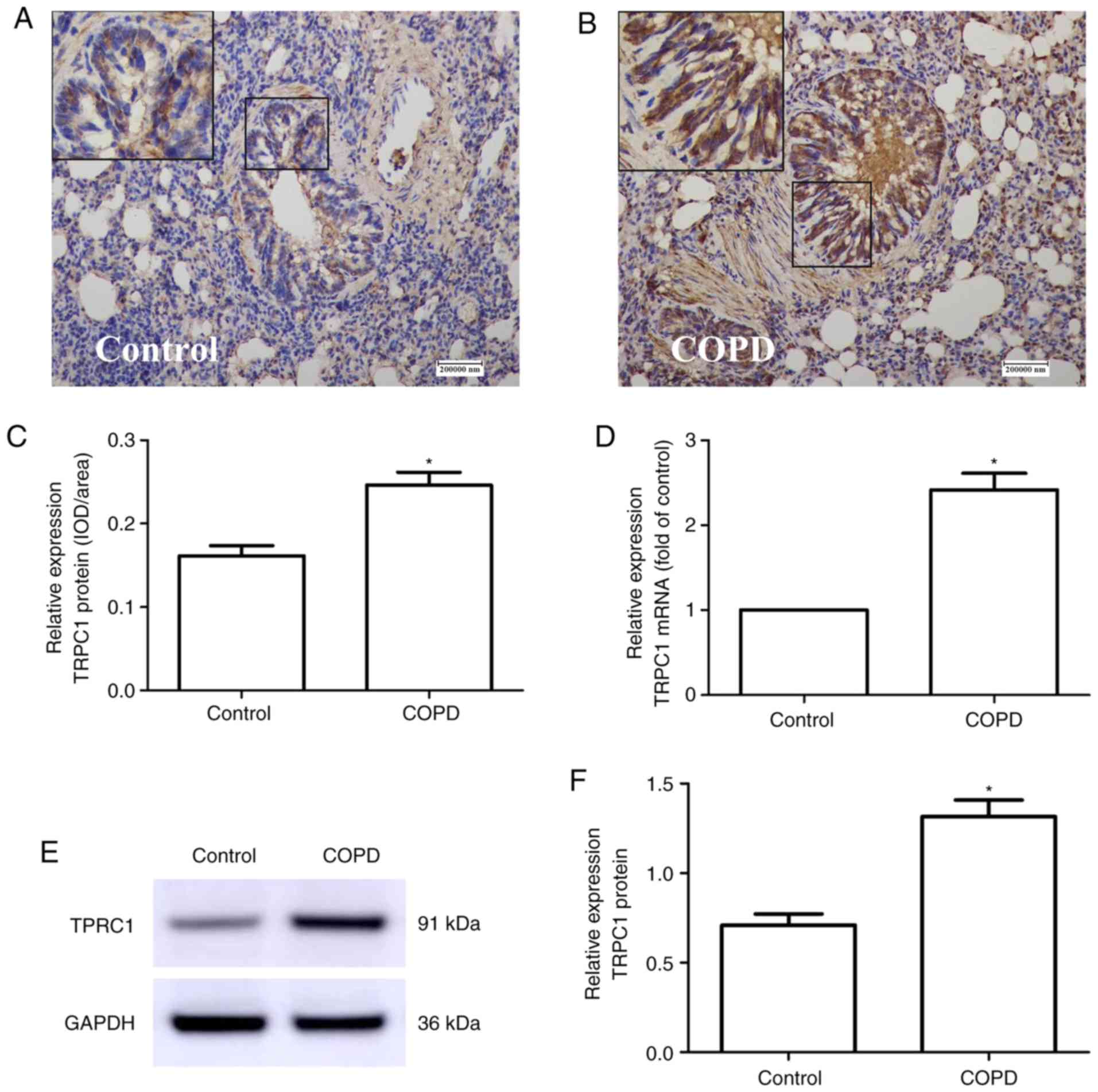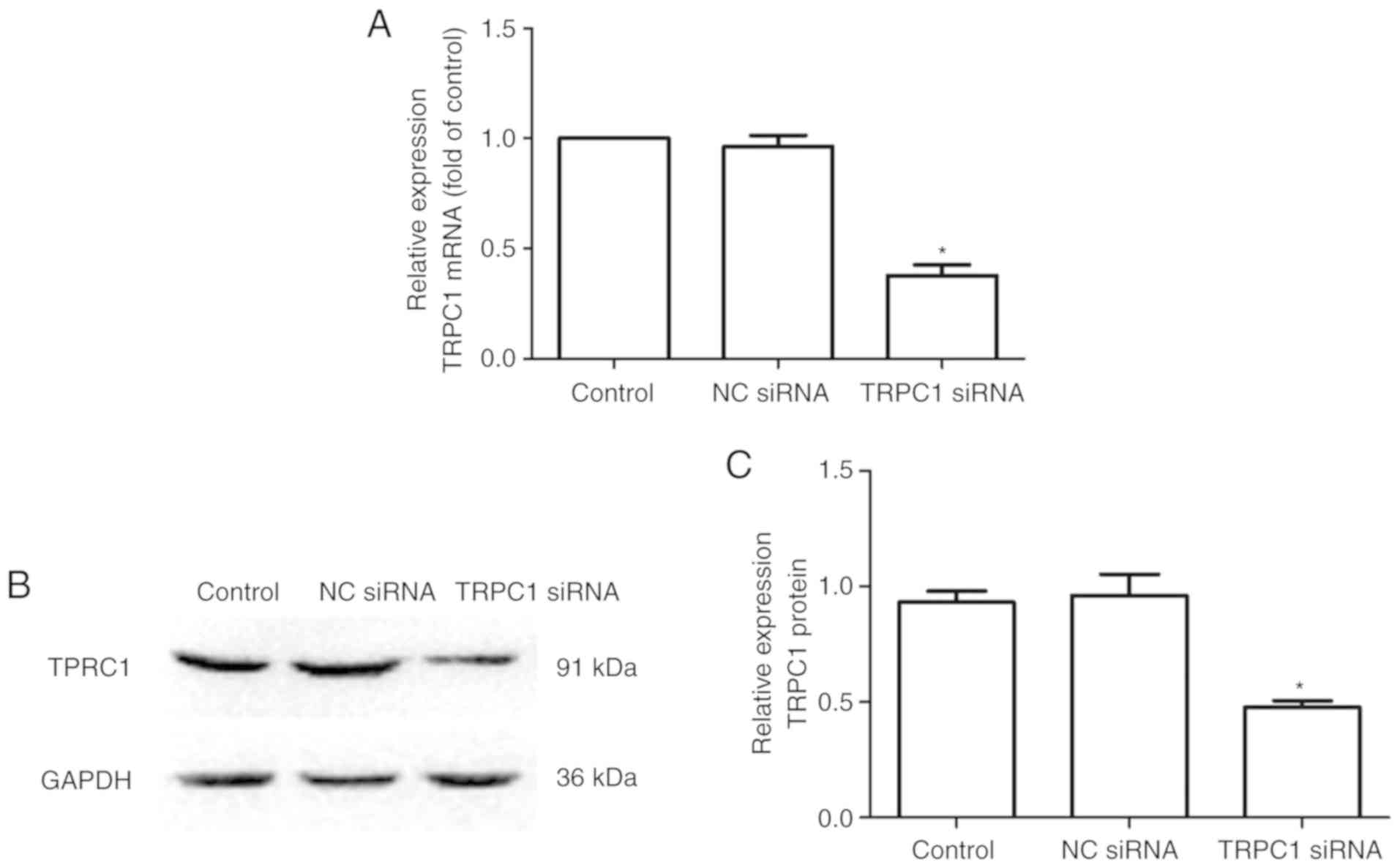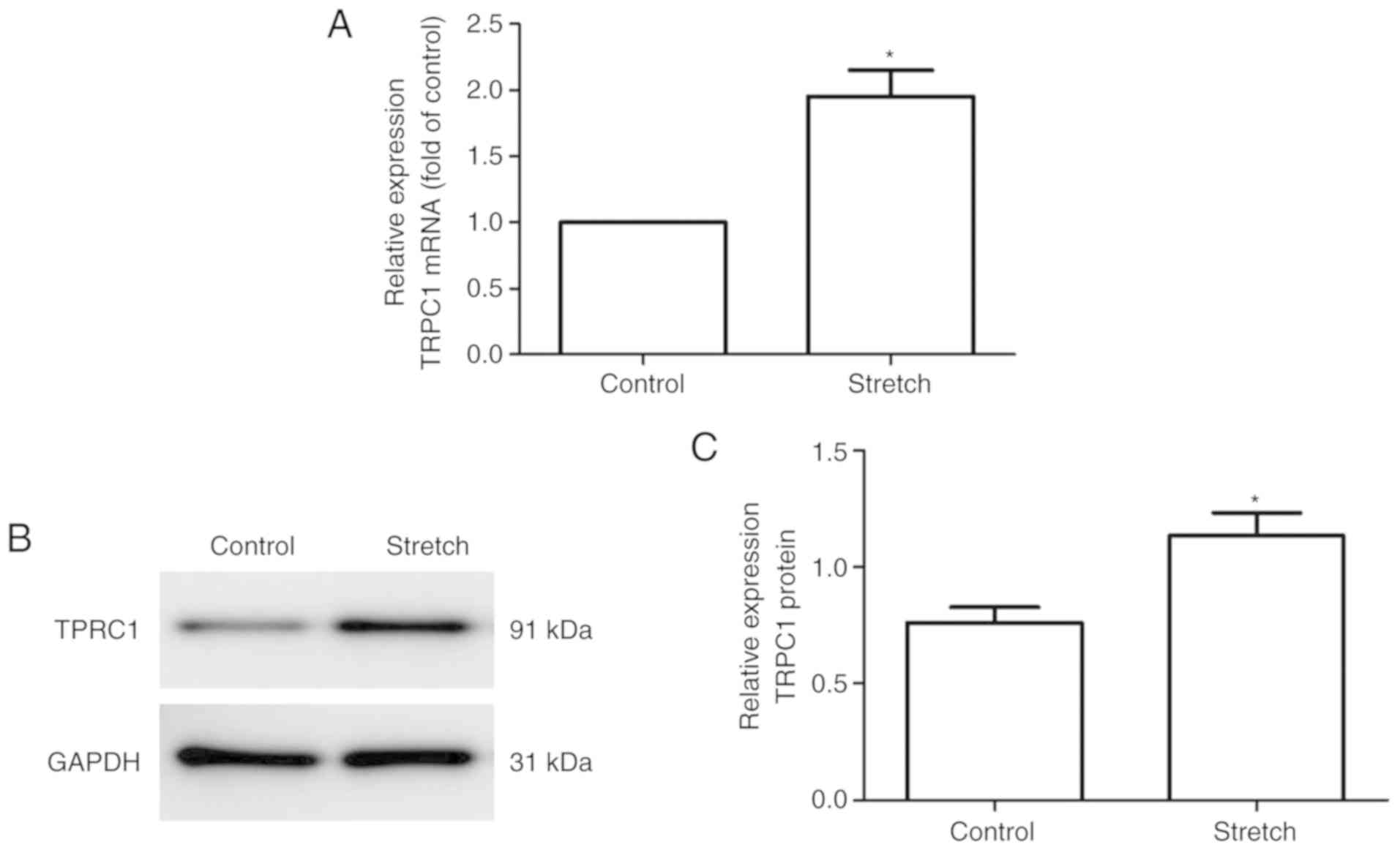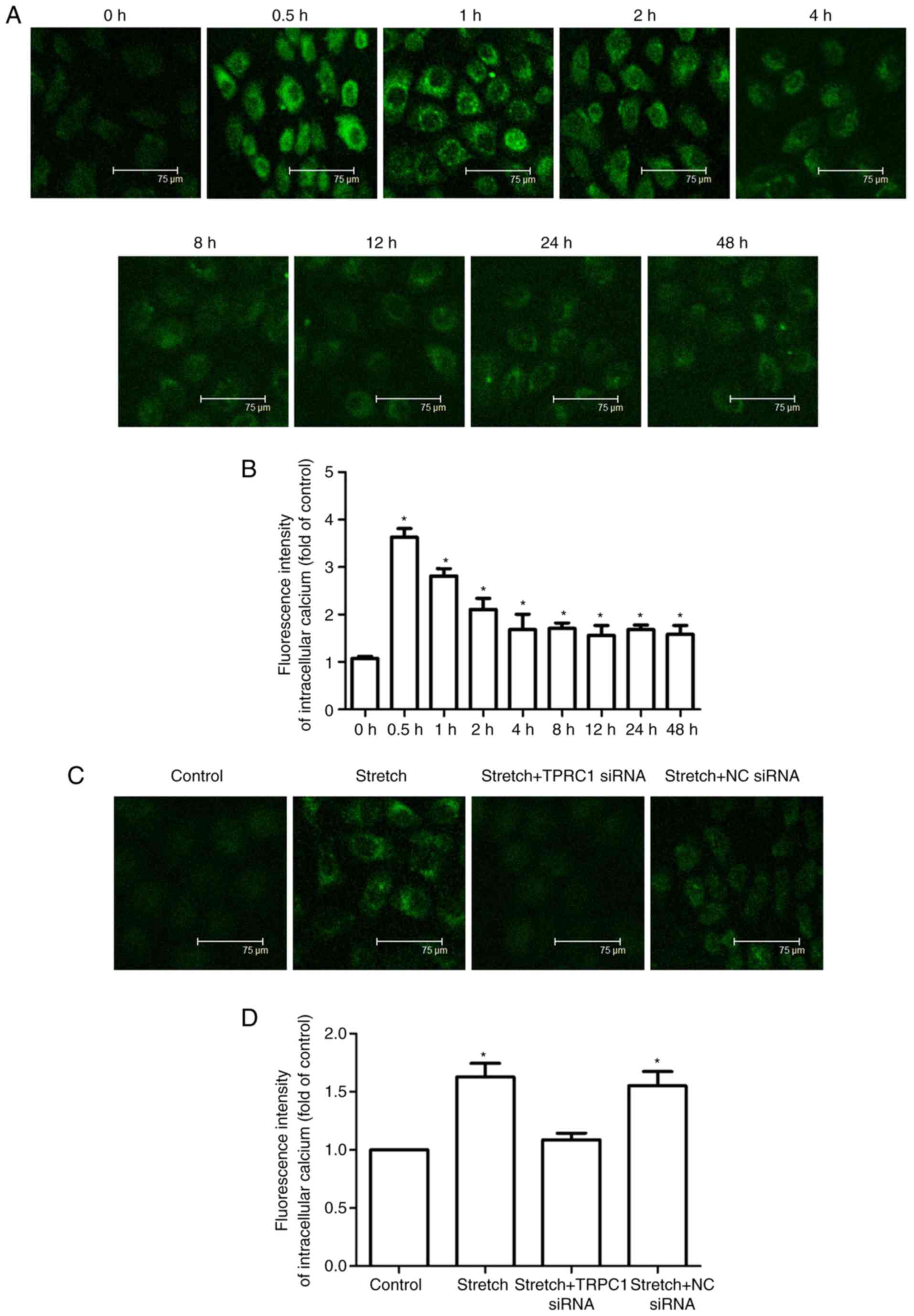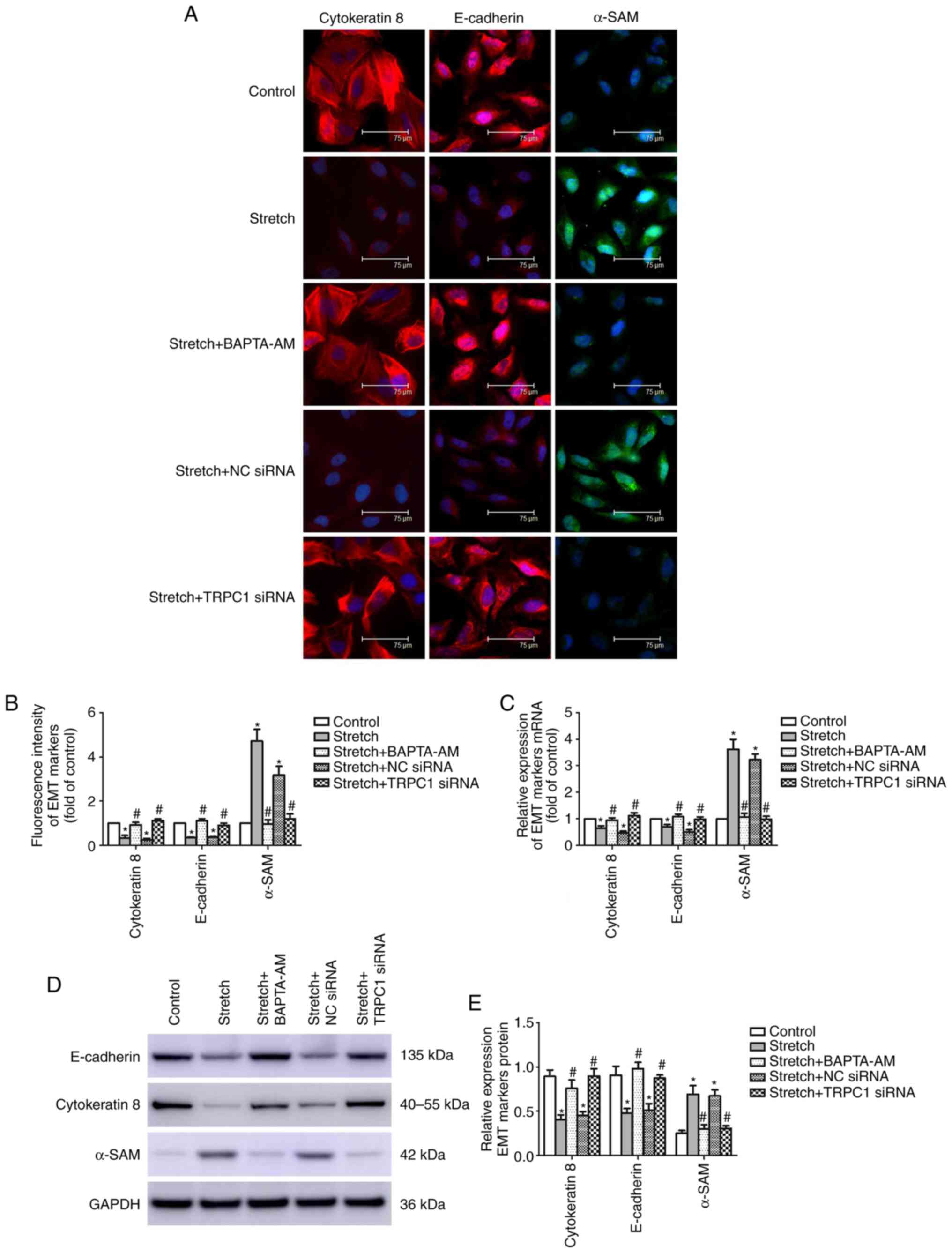|
1
|
Garcia CS, Prota LF, Morales MM, Romero
PV, Zin WA and Rocco PR: Understanding the mechanisms of lung
mechanical stress. Braz J Med Biol Res. 39:697–706. 2006.
View Article : Google Scholar : PubMed/NCBI
|
|
2
|
Yu Q and Li M: Effects of transient
receptor potential canonical 1 (TRPC1) on the mechanical
stretch-induced expression of airway remodeling-associated factors
in human bronchial epithelioid cells. J Biomech. 51:89–96. 2017.
View Article : Google Scholar
|
|
3
|
Birukova AA, Tian Y, Meliton A, Leff A, Wu
T and Birukov KG: Stimulation of Rho signaling by pathologic
mechanical stretch is a 'second hit' to Rho-independent lung injury
induced by IL-6. Am J Physiol Lung Cell Mol Physiol. 302:L965–L975.
2012. View Article : Google Scholar : PubMed/NCBI
|
|
4
|
Park JA and Tschumperlin DJ: Chronic
intermittent mechanical stress increases MUC5AC protein expression.
Am J Respir Cell Mol Biol. 41:459–466. 2009. View Article : Google Scholar : PubMed/NCBI
|
|
5
|
Li N, Li Q, Zhou XD, Kolosov VP and
Perelman JM: Chronic mechanical stress induces mucin 5AC expression
in human bronchial epithelial cells through ERK dependent pathways.
Mol Biol Rep. 39:1019–1028. 2012. View Article : Google Scholar
|
|
6
|
Tschumperlin DJ and Drazen JM: Mechanical
stimuli to airway remodeling. Am J Respir Crit Care Med.
164:S90–S94. 2001. View Article : Google Scholar : PubMed/NCBI
|
|
7
|
Suki B, Sato S, Parameswaran H, Szabari
MV, Takahashi A and Bartolák-Suki E: Emphysema and mechanical
stress-induced lung remodeling. Physiology (Bethesda). 28:404–413.
2013.
|
|
8
|
Li N, He Y, Yang G, Yu Q and Li M: Role of
TRPC1 channels in pressure-mediated activation of airway
remodeling. Respir Res. 20:912019. View Article : Google Scholar : PubMed/NCBI
|
|
9
|
Ito JT, Lourenço JD, Righetti RF, Tibério
IFLC, Prado CM and Lopes FDTQS: Extracellular matrix component
remodeling in respiratory diseases: What has been found in clinical
and experimental studies? Cells. 8:pii: E342. 2019. View Article : Google Scholar
|
|
10
|
Jones RL, Noble PB, Elliot JG and James
AL: Airway remodelling in COPD: It's not asthma! Respirology.
21:1347–1356. 2016. View Article : Google Scholar : PubMed/NCBI
|
|
11
|
Pain M, Bermudez O, Lacoste P, Royer PJ,
Botturi K, Tissot A, Brouard S, Eickelberg O and Magnan A: Tissue
remodelling in chronic bronchial diseases: From the epithelial to
mesenchymal phenotype. Eur Respir Rev. 23:118–130. 2014. View Article : Google Scholar : PubMed/NCBI
|
|
12
|
Kalluri R and Weinberg RA: The basics of
epithelial-mesenchymal transition. J Clin Invest. 119:1420–1428.
2009. View
Article : Google Scholar : PubMed/NCBI
|
|
13
|
Lamouille S, Xu J and Derynck R: Molecular
mechanisms of epithelial-mesenchymal transition. Nat Rev Mol Cell
Biol. 15:178–196. 2014. View
Article : Google Scholar : PubMed/NCBI
|
|
14
|
Sohal SS, Reid D, Soltani A, Ward C,
Weston S, Muller HK, Wood-Baker R and Walters EH: Reticular
basement membrane fragmentation and potential epithelial
mesenchymal transition is exaggerated in the airways of smokers
with chronic obstructive pulmonary disease. Respirology.
15:930–938. 2010. View Article : Google Scholar : PubMed/NCBI
|
|
15
|
Sohal SS, Reid D, Soltani A, Ward C,
Weston S, Muller HK, Wood-Baker R and Walters EH: Evaluation of
epithelial mesenchymal transition in patients with chronic
obstructive pulmonary disease. Respir Res. 12:1302011. View Article : Google Scholar : PubMed/NCBI
|
|
16
|
Gohy ST, Hupin C, Fregimilicka C, Detry
BR, Bouzin C, Gaide Chevronay H, Lecocq M, Weynand B, Ladjemi MZ,
Pierreux CE, et al: Imprinting of the COPD airway epithelium for
dedifferentiation and mesenchymal transition. Eur Respir J.
45:1258–1272. 2015. View Article : Google Scholar : PubMed/NCBI
|
|
17
|
Milara J, Peiró T, Serrano A and Cortijo
J: Epithelial to mesenchymal transition is increased in patients
with COPD and induced by cigarette smoke. Thorax. 68:410–420. 2013.
View Article : Google Scholar : PubMed/NCBI
|
|
18
|
Xu F, Liu XC, Li L, Ma CN and Zhang YJ:
Effects of TRPC1 on epithelial mesenchymal transition in human
airway in chronic obstructive pulmonary disease. Medicine
(Baltimore). 96:e81662017. View Article : Google Scholar
|
|
19
|
Heise RL, Stober V, Cheluvaraju C,
Hollingsworth JW and Garantziotis S: Mechanical stretch induces
epithelial-mesenchymal transition in alveolar epithelia via
hyaluronan activation of innate immunity. J Biol Chem.
286:17435–17444. 2011. View Article : Google Scholar : PubMed/NCBI
|
|
20
|
Mao P, Li J, Huang Y, Wu S, Pang X, He W,
Liu X, Slutsky AS, Zhang H and Li Y: MicroRNA-19b mediates lung
epithelial-mesenchymal transition via
phosphatidylinositol-3,4,5-trisphosphate 3-phosphatase in response
to mechanical stretch. Am J Respir Cell Mol Biol. 56:11–19. 2017.
View Article : Google Scholar
|
|
21
|
Yang Y, Hu L, Xia H, Chen L, Cui S, Wang
Y, Zhou T, Xiong W, Song L, Li S, et al: Resolvin D1 attenuates
mechanical stretch-induced pulmonary fibrosis via
epithelial-mesenchymal transition. Am J Physiol Lung Cell Mol
Physiol. 316:L1013–L1024. 2019. View Article : Google Scholar : PubMed/NCBI
|
|
22
|
Maroto R, Raso A, Wood TG, Kurosky A,
Martinac B and Hamill OP: TRPC1 forms the stretch-activated cation
channel in vertebrate cells. Nat Cell Biol. 7:179–185. 2005.
View Article : Google Scholar : PubMed/NCBI
|
|
23
|
Banner KH, Igney F and Poll C: TRP
channels: Emerging targets for respiratory disease. Pharmacol Ther.
130:371–384. 2011. View Article : Google Scholar : PubMed/NCBI
|
|
24
|
Global Initiative for Chronic Obstructive
Lung Disease: Global strategy for the diagnosis, management, and
prevention of chronic obstructive pulmonary disease 2019 report.
https://goldcopd.org/gold-reports/.
Accessed December 2, 2018.
|
|
25
|
Livak KJ and Schmittgen TD: Analysis of
relative gene expression data using real-time quantitative PCR and
the 2(-Delta Delta C(T)) method. Methods. 25:402–408. 2001.
View Article : Google Scholar
|
|
26
|
Gillespie PG and Walker RG: Molecular
basis of mechanosensory transduction. Nature. 413:194–202. 2001.
View Article : Google Scholar : PubMed/NCBI
|
|
27
|
Marshall KL and Lumpkin EA: The molecular
basis of mechanosensory transduction. Adv Exp Med Biol.
739:142–155. 2012. View Article : Google Scholar : PubMed/NCBI
|
|
28
|
Humphrey JD, Schwartz MA, Tellides G and
Milewicz DM: Role of mechanotransduction in vascular biology: Focus
on thoracic aortic aneurysms and dissections. Circ Res.
116:1448–1461. 2015. View Article : Google Scholar : PubMed/NCBI
|
|
29
|
Yin J and Kuebler WM: Mechanotransduction
by TRP channels: General concepts and specific role in the
vasculature. Cell Biochem Biophys. 56:1–18. 2010. View Article : Google Scholar
|
|
30
|
Burkholder TJ: Mechanotransduction in
skeletal muscle. Front Biosci. 12:174–191. 2007. View Article : Google Scholar
|
|
31
|
Inoue R, Jian Z and Kawarabayashi Y:
Mechanosensitive TRP channels in cardiovascular pathophysiology.
Pharmacol Ther. 123:371–385. 2009. View Article : Google Scholar : PubMed/NCBI
|
|
32
|
Plant TD: TRPs in mechanosensing and
volume regulation. Handb Exp Pharmacol. 223:743–766. 2014.
View Article : Google Scholar : PubMed/NCBI
|
|
33
|
Nesin V and Tsiokas L: TRPC1. Handb Exp
Pharmacol. 222:15–51. 2014. View Article : Google Scholar : PubMed/NCBI
|
|
34
|
Cabrera-Benítez NE, Parotto M, Post M, Han
B, Spieth PM, Cheng WE, Valladares F, Villar J, Liu M, Sato M, et
al: Mechanical stress induces lung fibrosis by
epithelial-mesenchymal transition. Crit Care Med. 40:510–517. 2012.
View Article : Google Scholar
|
|
35
|
Rychkov G and Barritt GJ: TRPC1
Ca(2+)-permeable channels in animal cells. Handb Exp Pharmacol.
23–52. 2007. View Article : Google Scholar : PubMed/NCBI
|
|
36
|
Albert AP: Gating mechanisms of canonical
transient receptor potential channel proteins: Role of
phosphoinositols and diacylglycerol. Adv Exp Med Biol. 704:391–411.
2011. View Article : Google Scholar : PubMed/NCBI
|
|
37
|
Bosanac I, Michikawa T, Mikoshiba K and
Ikura M: Structural insights into the regulatory mechanism of IP3
receptor. Biochim Biophys Acta. 1742:89–102. 2004. View Article : Google Scholar : PubMed/NCBI
|
|
38
|
Letsiou E, Sammani S, Zhang W, Zhou T,
Quijada H, Moreno-Vinasco L, Dudek SM and Garcia JG: Pathologic
mechanical stress and endotoxin exposure increases lung endothelial
microparticle shedding. Am J Respir Cell Mol Biol. 52:193–204.
2015. View Article : Google Scholar :
|
|
39
|
Suryadevara V, Fu P, Ebenezer DL,
Berdyshev E, Bronova IA, Huang LS, Harijith A and Natarajan V:
Sphingolipids in ventilator induced lung injury: Role of
sphingosine-1-phosphate lyase. Int J Mol Sci. 19:pii: E114. 2018.
View Article : Google Scholar : PubMed/NCBI
|
|
40
|
Wang J, Chen Y, Lin C, Jia J, Tian L, Yang
K, Zhao L, Lai N, Jiang Q, Sun Y, et al: Effects of chronic
exposure to cigarette smoke on canonical transient receptor
potential expression in rat pulmonary arterial smooth muscle. Am J
Physiol Cell Physiol. 306:C364–C373. 2014. View Article : Google Scholar :
|
|
41
|
Jiang HN, Zeng B, Zhang Y, Daskoulidou N,
Fan H, Qu JM and Xu SZ: Involvement of TRPC channels in lung cancer
cell differentiation and the correlation analysis in human
non-small cell lung cancer. PLoS One. 8:e676372013. View Article : Google Scholar : PubMed/NCBI
|
|
42
|
Feng W, Guo J, Huang H, Xia B, Liu H, Li
J, Lin S, Li T, Liu J and Li H: Human normal bronchial epithelial
cells: A novel in vitro cell model for toxicity evaluation. PLoS
One. 10:e01235202015. View Article : Google Scholar : PubMed/NCBI
|















